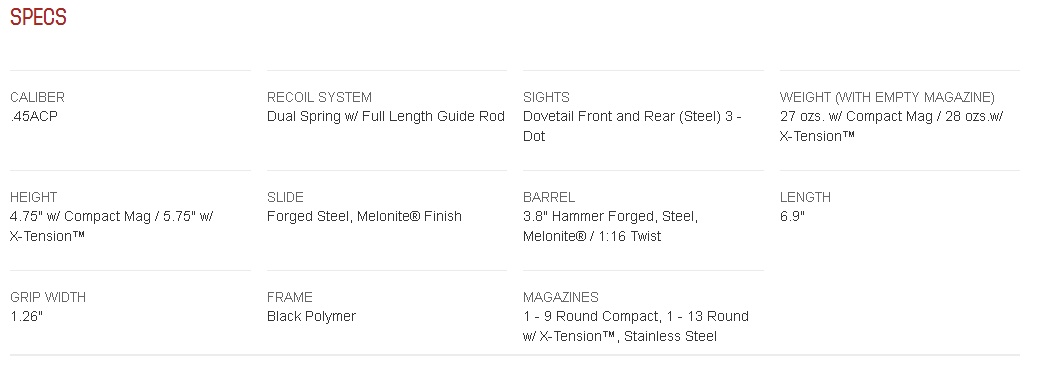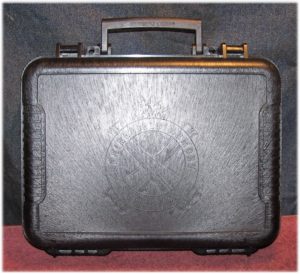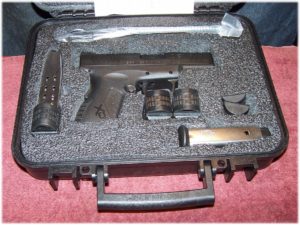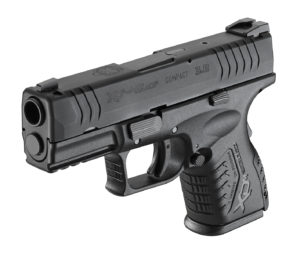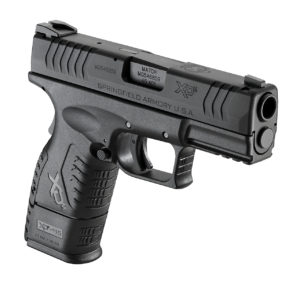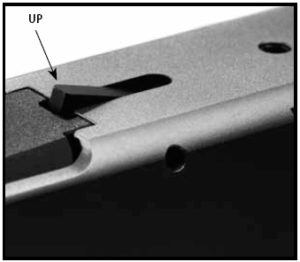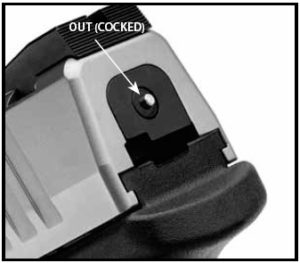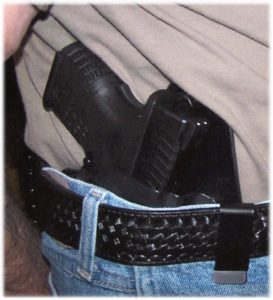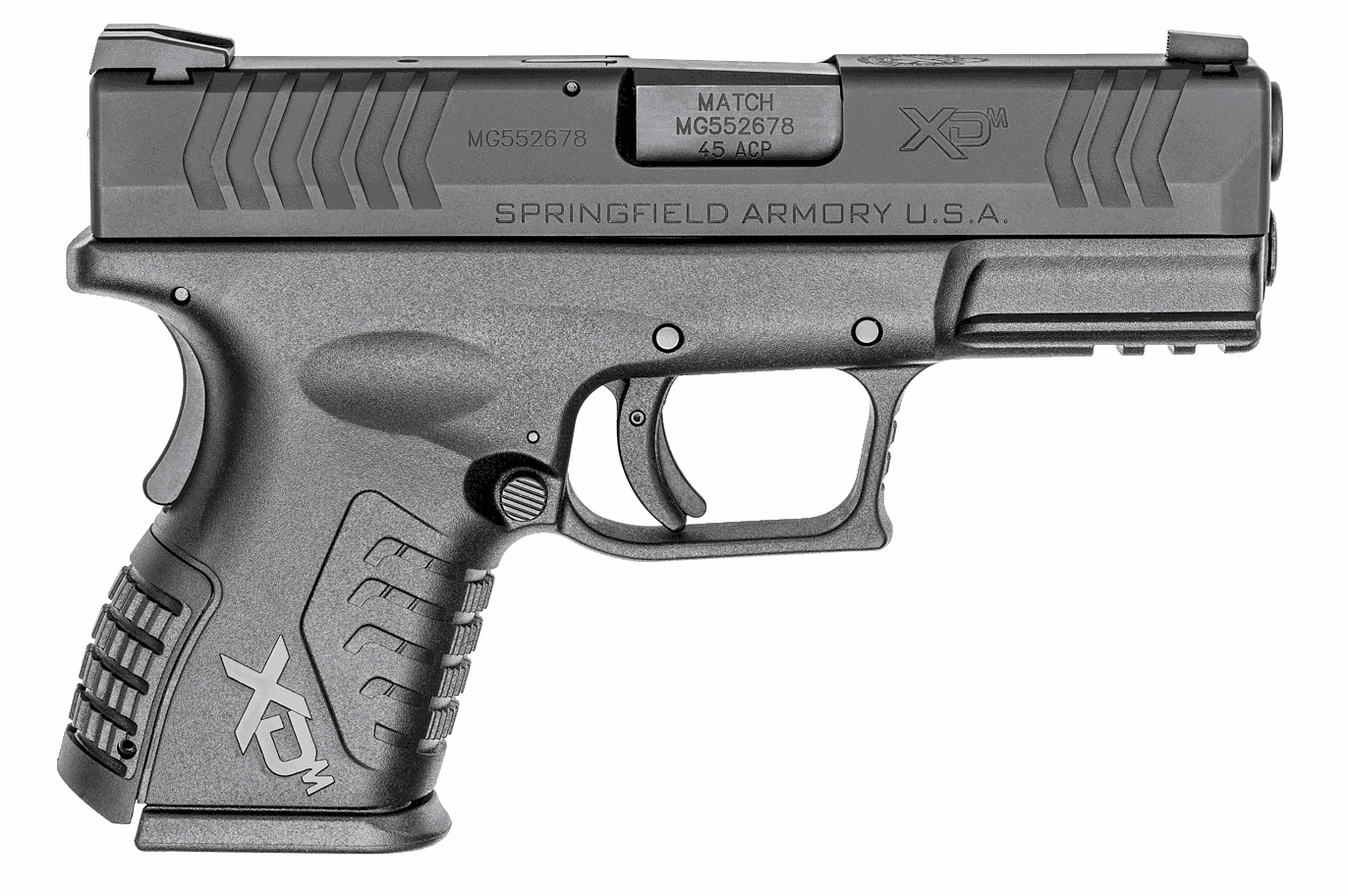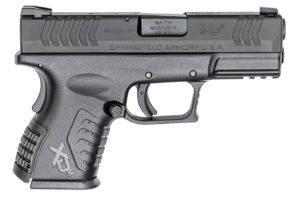 When I first became interested in what Springfield Armory had to offer it was in my quest to find a striker-fired polymer pistol (my first Springfield, by the way) as a comparison to the Glock G21 that I had recently purchased. The Springfield Armory XD 4.0 Service Model found its way into the fold. Unfortunately, a month later the XDm version hit the shelves. At the time, I could not justify purchasing the XDm even though it had many features over the standard XD, and which I’ll go into in the following write-up on the Springfield Armory XDm 3.8 Compact chambered in .45 ACP.
When I first became interested in what Springfield Armory had to offer it was in my quest to find a striker-fired polymer pistol (my first Springfield, by the way) as a comparison to the Glock G21 that I had recently purchased. The Springfield Armory XD 4.0 Service Model found its way into the fold. Unfortunately, a month later the XDm version hit the shelves. At the time, I could not justify purchasing the XDm even though it had many features over the standard XD, and which I’ll go into in the following write-up on the Springfield Armory XDm 3.8 Compact chambered in .45 ACP.
Many moons and pistols have passed since the purchase of the XD, including the XDs 4.0 in 9mm and .45 ACP chambering, and the 1911 Loaded and Loaded Compact. I never really gave the XDm a passing glance until lately.
The Springfield XD 4.0 is a full size service pistol and not one that is easily hidden away in an IWB holster. The Springfield XDs 4.0 in .45 ACP chambering is; however, very concealable but lacks capacity and is very narrow in the grip department. I was looking for a happy medium of size, capacity, and concealability (a Goldilocks version) that would be at home as a HD, PD, and range pistol.
The XDm incorporates a feature that I find comforting – a grip safety. The competitors had either no external safety or a thumb safety. As a student of the 1911-based pistol, I was fine with a thumb safety. I; however, was not fine with a pistol without any external safety on a pistol that might be carried. That is my preference and I stand by it. The Smith & Wesson was also considered, but I do not care for the “hinged” trigger. If Ruger made an SR45 Compact, that would be a contender; unfortunately, one does not exist. However, the thumb safety on the Ruger is not conducive to operating in normal conditions let alone under stress, but I do like the trigger.
I started taking a long and hard look again at Springfield Armory products and the Springfield Armory XDm 3.8 Compact chambered in .45 ACP in particular. Incidentally, the .45 ACP was the last version presented by Springfield with the 9mm and .40 S&W preceding it. It was not my first consideration, however. The Springfield Armory XDm 3.8 Compact chambered in 9mm was actually my first consideration. Why not? There is the 13+1 capacity with the standard magazine and a 19+1 capacity with the extended magazine. That would seem to be a plus in any one’s book, and I would agree that it is. I favor the .45 ACP over the 9mm; however, and it is as simple as that. I am not going to get into the proverbial 9mm vs. .45 ACP debate because I have my share of pistols in both calibers, they all shoot just fine and are far more accurate than my 10 MOA trigger flinch.
The Springfield Xdm 3.8 Compact comes in two flavors: Black Melanite (XDM93845CBHCE) and Bi-Tone (XDM93845CSHCE)
Now, my normal carry is a “Government” model 1911-based pistol. I am not going to try and compare the Springfield Armory XDm 3.8 Compact chambered in .45 ACP to the 1911; that would be like comparing apples to oranges and would be unfair. There are; however, enough similarities between two pistols that warrants thought. In addition, there are also things about the Springfield Armory XDm 3.8 Compact chambered in .45 ACP that, while not negative to me, are also worthwhile to engage in thought. I will attempt at times (although at a minimum) to draw a comparison between the Springfield Armory XDm 3.8 Compact chambered in .45 ACP and the Glock G30 that, historically, precedes the Springfield Armory XDm 3.8 Compact chambered in .45 ACP and is a more fair comparison.
SAY HELLO TO “TAZ!”
The Springfield Armory XDm (X-Treme Duty, the M is for the match grade barrel and match grade trigger) is the successor of sorts to the XD series of pistols. The basic specifications are shown below for the Springfield Armory XDm 3.8 Compact chambered in .45 ACP and with the finish that I desired.
Not shown in specifications:
The slide measures 1.075 inches at bottom where it is the widest. It tapers toward the top to about .930 inches before the bevel. The frame measures 1.190 inches in the middle and 1.040 at the front. The slide width measurement on my 1911 is approximately 0.918 inches. Also for comparison, the slide width of the Glock G30 is 1.128 (approximate).
WHAT’S IN THE SUITCASE?
The Springfield Armory XDm 3.8 Compact comes securely housed in a hard polymer compact carrying case that also includes; two stainless-steel magazines (1-9 round and 1-13 round where allowed; otherwise a 10-round (See, Note 1) magazine is offered) with polymer base-plates, cable lock, owner’s manual and other paperwork, fired cartridge case, two back strap inserts for adjusting grip width, two slip-on magazine extensions for the 13-round magazine (or 10-round magazine – See Note 1) that are contoured for different back straps, a nylon bore brush,and a chamber-flag.
In the past, Springfield included “The Essentials” that consisted of a paddle-holster, double magazine pouch, and magazine loader. Apparently, Springfield has stopped providing “The Essentials” and provides only what is actually desired by most. Most folks discarded, or did not use, the holster, magazine pouch, and magazine loader anyway. It was a nice touch, but it seems Springfield chose not to provide them anymore (they can be purchased separately through Springfield web site). The providing of “The Essentials” also resulted in a somewhat large “suitcase” that brought about some glib comments.
Note 1: The 9-round magazine is a flush fit magazine and works well for CC. The 10-round and 13-round magazines are extended magazines and have the same outside dimensions. A magazine sleeve may or may not be used as determined by the operator. Although Pierce does make grip extensions for the XDM compact they are only for the 9mm and .40S&W versions of this pistol at the time of this review.
JUDGING THE BOOK BY ITS COVER:
In the Springfield world of polymer pistols, the Springfield Armory XDm 3.8 Compact falls in between the XDm 4.5-inch model and the XDs 3.3-inch model in terms of capacity, barrel length, and size with the standard 9-round magazine – more like an “officer’s model 1911. With the 13-round magazine, the pistol takes on a persona of a short-barreled, full-grip grip pistol and would be comparable to the XDm 3.8, which is not a bad thing to be comparable to. If compared to the Glock .45 ACP series of pistols, the Springfield Armory XDm 3.8 Compact could be considered as being similar to a G36 or a G30 depending on which magazine is inserted into the magazine well of the Springfield.
The aesthetics are pleasing, but the texturing of the pistol could be considered somewhat busy by some. However, the texturing is busy in all of the right places and the pistol has a balanced look to it with the standard 9-round magazine. With the 13-round extended magazine in place; however, the balanced look of the pistol goes away and I am reminded of Kim Kardashian’s rear end; while it adds dimension to the body it is really too big for a small frame. With that said, I am not going to complain about having a few more rounds of .45 ACP ammunition on hand. Kim Kardashian’s butt, on the other hand, could use some reduction. But, that’s my opinion and opinions will vary. For now, I will address the butt that I can get a hand on.The Slide, Guide, and Barrel:
 The slide on my particular pistol has an evenly-applied Melonite treatment; a salt bath nitriding process that leaves a hard, corrosion-resistant surface. A Bi-Tone option is also available, but for concealed carry I prefer black.
The slide on my particular pistol has an evenly-applied Melonite treatment; a salt bath nitriding process that leaves a hard, corrosion-resistant surface. A Bi-Tone option is also available, but for concealed carry I prefer black.
Sitting atop the slide is a set of three-dot sights that are drift adjustable for windage. I actually prefer the three-dot sight arrangement more than the fiber-optic front sight. The three-dot system is easy to pick up in the daylight hours, but I will probably exchange these with the XS Big Dot Night Sights or Hi-Vis units if the pistol is to be adopted for EDC. The stock sights; however, are more than adequate for daylight use and I have simply painted the front dot with a dab of florescent red. The rear sight is, seemingly, a NOVAK style, but there is a small ledge on the foreword edge that would allow “one-hand’ racking of the slide against a hard surface.
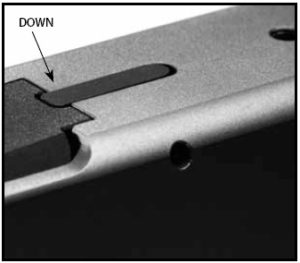 Incorporated into the top of the slide is a spring-loaded “Loaded Chamber Indicator” – a pop-up indicator that provides both visual and tactile confirmation that a round is chambered. The “Loaded Chamber Indicator” is not as obtrusive, in my opinion, as many that I have encountered.
Incorporated into the top of the slide is a spring-loaded “Loaded Chamber Indicator” – a pop-up indicator that provides both visual and tactile confirmation that a round is chambered. The “Loaded Chamber Indicator” is not as obtrusive, in my opinion, as many that I have encountered.
The extractor is internal to the slide.
I like how the slide contours as compared to the squared-off slide of the Glock pistols. I also like how Springfield decided to bevel the forward edge of the slide, which allows for smoother insertion of the pistol into a holster and should also lessen holster wear, especially for leather holsters.
The recoil system is a metal (hollow aluminum), captured, full-length dual spring affair that separates the Springfield pistol from most polymer pistols that use polymer guide rods, and it works quite well for protecting the pistol during recoil and also for chambering fresh round. I mention more about recoil in “HOPE, HOPE ON THE RANGE.”
The slide is serrated front and rear to accommodate racking the slide. The serrations blend nicely into the top of the slide and, while providing a good gripping surface, are not intrusive on the hand. The cocking serrations are molded into somewhat of a chevron pattern and are really quite pleasing.
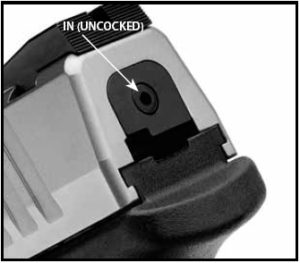 Springfield has incorporated a “Striker Status” indicator on the rear of the slide. When the pistol is cocked, a pin protrudes from the rear and provides a visual and tactile means to determine the firing status of the pistol. When the grip safety is pressed, when the trigger is pulled (more on the trigger in “Triggering My Fancy or Fancying My Trigger?”), and the striker is released, the pin drops into its recess.
Springfield has incorporated a “Striker Status” indicator on the rear of the slide. When the pistol is cocked, a pin protrudes from the rear and provides a visual and tactile means to determine the firing status of the pistol. When the grip safety is pressed, when the trigger is pulled (more on the trigger in “Triggering My Fancy or Fancying My Trigger?”), and the striker is released, the pin drops into its recess.
All XDm series of pistols comes with a ‘Match Grade” barrel. I know that because MATCH is laser-etched on the outside of the chamber. Match Grade barrels are manufactured to tighter tolerances and custom-fitted for better accuracy and to make the pistol “competition ready.” Like the slide, the barrel has also received the Melonite treatment. The barrel utilizes a beefy locking block system that is common to many polymer pistols. The fully supported and polished feed-ramped barrel ensures proper chambering and also protection against case blow-out.
A plus of the barrel is that it uses traditional rifling. What that means is that you need not be concerned with pushing lead bullets down the barrel as you would with that “other” very popular pistol without first purchasing an after-market barrel.
If you are a fan of laser etching, you should be in seventh-heaven with the Springfield Armory XDm 3.8 Compact because there is plenty of information for reading on the slide and which will remind you what pistol you are carrying, lest you forget.
The Frame and Coming to Grips with It:
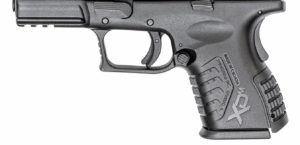
Starting at the front end of the frame you will find a Picatinny accessory rail integrated into the dust cover for mounting lights, lasers, and such. Swooping rearward on the left side of the frame is the Disassembly Lever, which is nicely blended into the frame and is lightly serrated to allow for ease of use. The frame is indented just forward of the Disassembly Lever, possibly to ease the installation and removal of accessories, but may be an attempt to keep the frame weight down.
Just rearward of the Disassembly Lever is the Slide Stop Lever that is also blended well into the frame. Mild serrations top and bottom allow for positive operation with the shooting or support hand thumb. The Slide Stop Lever is well placed and reaching it with my hand without changing grip is a nice feeling. Even operators with short thumbs should have no problem reaching the Slide Stop Lever.
There is no thumb safety on this particular pistol.
The trigger guard is squared-off at the front and is also serrated to provide a good purchase for a weak hand finger should you so desire to use that method. The trigger guard is large enough to accommodate a gloved hand.
Moving rearward of the trigger guard is the magazine release, which is ambidextrous and a feature that I have come to like on any pistol. The magazine release operates very positively in both directions with empty magazines, but is slightly stiff with fully or partially-loaded new magazines. The magazine release button is well protected by the surrounding frame and seems to be protected enough to prevent accidental operation but yet is easy enough to access when needed. In my hand, and with the #2 (medium) grip adapter in place, the magazine release is easily within thumb’s reach.
The grip is nicely sculptured with patterns on the front and the sides where the shooting hand needs a good gripping surface. You know that you are gripping an XDm because it is well marked on each side of the grip along with some other information. (At least Springfield did not try to remind you where to grip the pistol as they did with the Mod2 with its “Grip Zone” in the handle.)
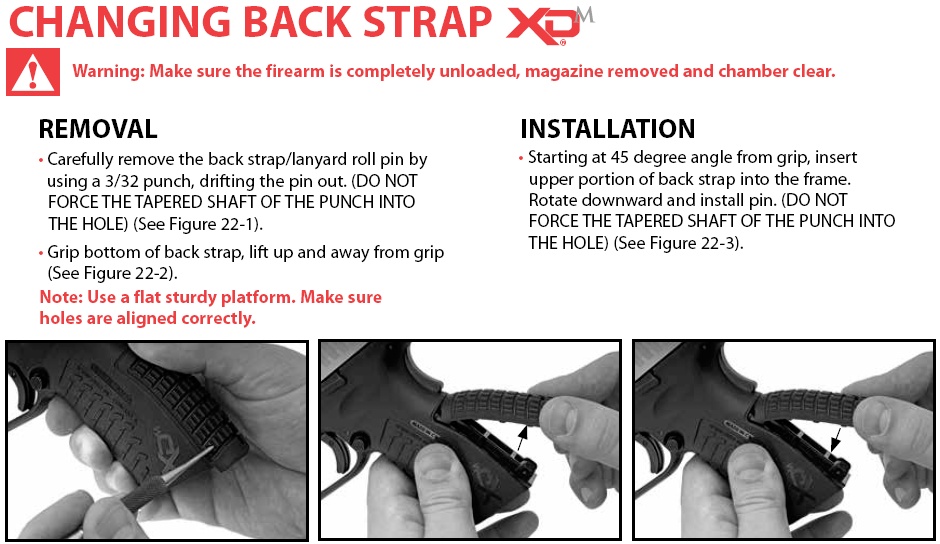
The rear grip texturing is provided by easily replaceable back strap sections that are used to accommodate varying hand sizes. Personally, and because of the short grip length with the standard 9-round magazine, I found that the #2 arched of the grip adapters hit my hand just right, but I may experiment with the #1 and #3 grip adapters more as time goes on. The pistol comes equipped with the “medium – #2” adapter installed.
The pistol incorporates a very nice beaver-tail that allows me to get as high a grip on the pistol as possible. Integrated into the grip is the grip safety and is a feature that I really appreciate on a striker-fired pistol. I cover more on the grip safety in “LIVING IN RELATIVE SAFETY.”
The grip width on the Springfield Armory XDm 3.8 Compact measures approximately 1.26” and is actually thinner than most of my 1911-based pistols that are equipped with the Hogue Monogrip Rubber wrap-a-round grip with finger grooves, which measures 1.28 inches in width. I have become accustomed to finger grooves on my carry pistols and would like them on the Springfield Armory XDm 3.8 Compact, but I do not want to interfere with the operation of the grip safety, the grip surface is more than adequate, and I will probably refrain from adding a grip sleeve unless I can manage to clear the grip safety. Some experimentation in this department may take place at some point.
With the standard 9-round magazine in place, it gets pretty crowded for me to fit three fingers on the grip. I normally use only two fingers for gripping anyway and having the little finger under the base-plate of the magazine doesn’t bother me at all. I have come to use an “Interlocking Pinky” grip, at times, when shooting short-frame pistols.
With the extended magazine in place, the grip is as full as you can get and is equivalent to full size XD and XDm pistols. A grip sleeve can be selected from the three that come with the pistol to mate the magazine to the replaceable back-strap. While not seamless, the magazine sleeves mate very well to the frame. The magazine sleeves are also textured to match that on the frame.
The grip is nicely indented to provide a thumb rest if I use the thumbs-down, thumb-over grip, but my thumbs are usually high and pointed toward the target (in most cases) as I am used to riding the thumb safety when shooting the 1911.
Unloaded, the Springfield XDm 3.8 Compact has a slight top-heavy feel to it. When loaded with a full magazine; however, that feeling goes away and the pistol feels nicely balanced – even with the 13-round magazine.
Triggering My Fancy or Fancying My Trigger?
 The trigger on the Springfield Armory XDm 3.8 Compact is considered, by Springfield, as a match trigger. The trigger is referred to as the USA (Ultra Safety Assurance) Trigger. The trigger incorporates the “trigger flapper” in the center of the trigger paddle not unlike many other polymer striker-fired pistols. If the trigger finger is not resting square on the trigger, the trigger cannot be pressed further and no bang happens unless the grip safety is also properly pressed into service.
The trigger on the Springfield Armory XDm 3.8 Compact is considered, by Springfield, as a match trigger. The trigger is referred to as the USA (Ultra Safety Assurance) Trigger. The trigger incorporates the “trigger flapper” in the center of the trigger paddle not unlike many other polymer striker-fired pistols. If the trigger finger is not resting square on the trigger, the trigger cannot be pressed further and no bang happens unless the grip safety is also properly pressed into service.
The point at which the striker releases is very close to the frame of the pistol, which means that you don’t have to release the trigger far in order to obtain quick follow up shots. Cocking occurs, I would say, somewhere around the slide moving rearward about 1/8-inch of rearward travel. Once the initial take-up is made with the trigger safety lever, there is a short amount of secondary take-up, a little heavier bit of resistance, and then the striker is released. Unlike my XD and XDs pistols, the actual release point on the XDm’s trigger seems a bit crisper. The trigger pull weight on the Springfield Armory XDm 3.8 Compact is approximately 5.5 pounds, which is a good weight on a defensive pistol.
Personally, I like a bit of “safe zone” in my triggers on pistols meant for self defense. I prefer the trigger on the Springfield over the Glock, but I like the trigger on the Ruger SR series of pistols over the Springfield. However, I am very adaptable to all. There is ample opportunity to back off of a shot or to fully commit to the shot with the Springfield Armory XDm 3.8 Compact’s trigger.
The trigger is very predictable once you attune yourself to it. I like predictability in a trigger when I am trying for a precise shot – I don’t like surprises or guesswork when pulling a trigger.
As a last few words on the grip, I am going to give a two points for comfort to the Glock G30. The mild texturing of the grip on the Glock G30 feels better in the hand over the somewhat aggressive texturing of the Springfield XDm Compact. The second point goes to the magazine, actually. The magazine base of the Glock G36, which the Springfield XDm Compact 45 would be comparable to, has enough surface area to allow for all three fingers of the shooting hand to rest; whereas, the magazine base on the Springfield XDm Compact has much less surface area and the little finger is pretty much left hanging.
I have added Pierce grip extensions (0-round) on my Glock G36 magazines that allows more room for the little finger to rest upon. I would like to see Pierce add a magazine extension for the 45 version of the Springfield XDm Compact simply for one reason – removing the pistol from the holster. While I do grip a pistol with only two fingers when firing, I like a three-finger grip on a pistol when drawing from the holster. While I can, with some concentration, get a three-finger grip on the handle more likely than not it will only be two fingers with my little finger under the base-plate of the magazine. The small lip on the Pierce grip extension provides a means for the little finger to “hook” the magazine as the hand withdraws the pistol from the holster and makes for a more positive draw stroke.
With all of this said, I have began practicing a different draw stroke. I cover more on this in “AT HOME ON THE BODY:.”
LIVING IN RELATIVE SAFETY:
Like the Glock pistol, Springfield incorporates all the usual safeties; drop safety and trigger safety. However, Springfield goes a couple of steps further with safeties; a Striker Block Safety and a Grip safety.
The Striker Block Safety prevents the pistol from firing unless the Trigger Safety and the Grip Safety are fully pressed.
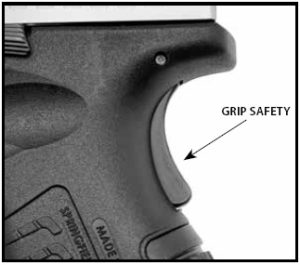 The Grip Safety, in the case of the Springfield Armory XDm 3.8 Compact, is utilized in several conditions; it prevents the pistol from firing unless the Trigger Safety and Grip Safety is properly pressed, and also prevents the slide from moving rearward unless the Grip Safety is fully pressed. In Springfield terms, these are known as “passive” safeties because the operator does not have to think consciously about them (like the thumb safety on a 1911). Some may not like the fact that the slide cannot be pulled rearward unless the Grip Safety is pressed, but it is not an issue once you get used to it. When you stop and think about it, it is no worse than the thumb safety on a 1911 that will not allow the slide to move rearward unless the thumb safety is in the “Off Safe” position. Picky, picky, picky!
The Grip Safety, in the case of the Springfield Armory XDm 3.8 Compact, is utilized in several conditions; it prevents the pistol from firing unless the Trigger Safety and Grip Safety is properly pressed, and also prevents the slide from moving rearward unless the Grip Safety is fully pressed. In Springfield terms, these are known as “passive” safeties because the operator does not have to think consciously about them (like the thumb safety on a 1911). Some may not like the fact that the slide cannot be pulled rearward unless the Grip Safety is pressed, but it is not an issue once you get used to it. When you stop and think about it, it is no worse than the thumb safety on a 1911 that will not allow the slide to move rearward unless the thumb safety is in the “Off Safe” position. Picky, picky, picky!
The grip safety I have come to know and appreciate on my 1911-based (and other) pistols. And the appreciation is not so much when shooting the pistol as it is appreciated when holstering the pistol.
When I holster a 1911-based pistol, the thumb safety is in the “safe” (up) position and the grip safety is not pressed; I hold onto the pistol with two fingers, the trigger finger out of the trigger guard, and the thumb on the hammer as the pistol is slid into the holster. The drill is the same with any Springfield polymer pistol, sans the thumb safety. The hand is free from the grip safety and the thumb is placed on the rear of the slide. Also, there is no worry about the pistol coming out of battery as the grip safety prevents the slide from opening unless the grip safety is fully pressed.
When drawing any Springfield pistol, I do not get a complete grip until the pistol is aimed toward the target; the grip safety is not fully pressed until I tighten my grip on the pistol. With the 1911-based pistol, I can get a full grip on the pistol; however, I have the added responsibility to control the thumb safety, but I pretty much follow the same motion with pistols that do not incorporate a thumb safety.
The beauty of a grip safety is if I need to hold off on the shot, I can simply relax my grip and release the grip safety slightly. The other beauty of a grip safety is that I can safely holster the pistol without concern that something might “grab” the trigger, the pistol fires, and I get to be amazed at how big a hole a .45 ACP bullet can make in my body and the massive amount of pain and blood loss that ensues after doing so.
One needs to consider that John Browning thought the grip safety was adequate for the gun that became the Model of 1911. The thumb safety was an afterthought by the military. Browning’s personal “1911,” made in 1910, has no thumb safety. Earlier Browning designs, made by Colt and FN, have grip safeties.
The Springfield Armory XDm 3.8 Compact does not incorporate a “magazine safety.” While some bad mouth magazine safeties, they can be advantageous at times, but I am not here to get into that discussion. The Springfield Armory XDm 3.8 Compact makes you think about what you are doing with the pistol. If the magazine is out of (or in) the pistol, a “Chamber Loaded Indicator” and “Striker Status” indicator will tell you the condition of the pistol. If the “Chamber Loaded” indicates a loaded chamber, the “Striker Status” indicator tells you that the pistol is cocked, the Grip Safety is pressed, and the Trigger Safety is properly pressed, the pistol will fire that chambered round.
Safety is something that we should never stop thinking about and I like the safety features on the Springfield Armory XDm 3.8 Compact. I would rather have my actions be safe than be shot with a “Safe-Action” trigger that is accidentally, well, triggered . But, that is just me.
ALRIGHT NURSE, I’M GOING IN!
So far, I have presented the externals of the pistol with a slight glimpse at some of the internals. And, while I am not trying to sell this pistol (although I may in the future and this part may help me do so), you don’t buy a car without looking under the hood (I never did figure out that “kicking the tires” thing). Note that you may want to ask your LGS if it is alright to field strip the pistol before attempting to do so. Courtesy and all of that, you know.
Disassembly:
Note before proceeding with disassembly: You do not have to pull the trigger to disassemble the pistol. However, that does not mean that you neglect to ensure that the pistol is not loaded, that a round is not chambered, and that the magazine is out of the firearm. Remember that this is a thinking man’s game. Be safe – always!
- After the pistol is deemed safe, fully press the grip safety.
- Move and lock the slide all the way to the rear.
- Flip the disassembly lever upward until it is vertical.
- Push or pull the slide slightly to the rear to disengage the slide stop lever.
- (Note: The slide is under spring tension.) Move the slide slowly forward and off of the frame.
- Turn the slide so that the bottom of the slide is facing up.
- (Note: The recoil assembly is under spring tension.) Remove the guide rod assembly from the slide.
- Remove the barrel from the slide.
Inspection:
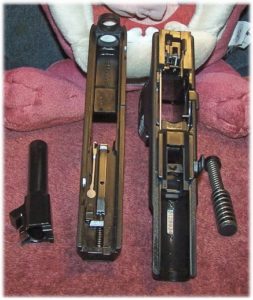 The internals of a firearm are pretty revealing; they can indicate the quality of manufacturing and workmanship that went into the pistol’s build as well as the design effort.
The internals of a firearm are pretty revealing; they can indicate the quality of manufacturing and workmanship that went into the pistol’s build as well as the design effort.
Since your LGS may not allow you to field strip the pistol for inspection, I’ll give you a head’s up here.
The machining of the slide assembly is most excellent.
The extractor is internal to the slide. I prefer internal to external extractors.
The slide of the Springfield XDm 3.8 Compact is a little bit more complex than the slide on the G30 due to the grip safety and internal extractor.
The frame assembly is a little bit more complicated due to the grip safety and its interaction with the trigger safety. The frame of the Springfield XDm 3.8 Compact is actually heavier than the frame of the Glock G30. There are also structural differences between the XDm 3.8 Compact .45ACP and the Glock G30 (and other Glock pistols) that, I feel, are important to note because I have seen some damaged Glock pistols at a very important stress point. Let me explain a bit.
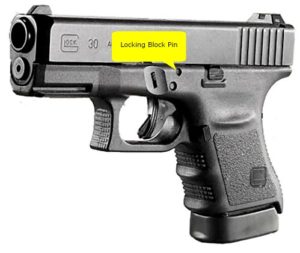 On the Glock G30, just above the “Trigger Housing Pin” is a smaller pin that is known as the “Locking Block Pin.” The “Locking Block Pin” is very close to the top of the frame. I have seen Glock pistols with cracks in the frame just above and including the “Locking Block Pin” hole. I think that this is an inherent weakness in the Glock pistols. The cause of this “stress fracture,” I can only assume, is the forcible slamming of the barrel into the locking block over a period of time.
On the Glock G30, just above the “Trigger Housing Pin” is a smaller pin that is known as the “Locking Block Pin.” The “Locking Block Pin” is very close to the top of the frame. I have seen Glock pistols with cracks in the frame just above and including the “Locking Block Pin” hole. I think that this is an inherent weakness in the Glock pistols. The cause of this “stress fracture,” I can only assume, is the forcible slamming of the barrel into the locking block over a period of time.
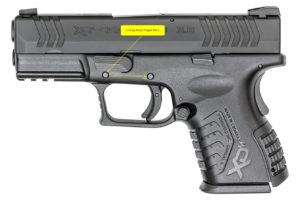 With the Springfield line of pistols, the forward “Locking block/Trigger Pin-2” is in the “meat” of the frame as is the rear “Locking block/Trigger Pin-2.” The Locking block of the Springfield XDm 3.8 Compact is substantial, steel, and incorporates a healthy rail system in its design. Rearward forces of the barrel impacting the “Locking Block” are distributed throughout the frame; whereas, in the vertical securing system of the Glock pistol, the upper “Locking Block Pin” is taking quite a beating in my opinion.
With the Springfield line of pistols, the forward “Locking block/Trigger Pin-2” is in the “meat” of the frame as is the rear “Locking block/Trigger Pin-2.” The Locking block of the Springfield XDm 3.8 Compact is substantial, steel, and incorporates a healthy rail system in its design. Rearward forces of the barrel impacting the “Locking Block” are distributed throughout the frame; whereas, in the vertical securing system of the Glock pistol, the upper “Locking Block Pin” is taking quite a beating in my opinion.
The frame of the Springfield XDm 3.8 Compact is, in my opinion, far more robust than that of the Glock pistol – any Glock pistol – and I have enough of them for comparison.
At the rear of the frame, you will find a substantial polymer rail system for the slide. The entire rails system, I feel, is superior to the Glock. If Glock was a Ford truck, the Springfield would be a Doge Ram truck.
Re-Assembly:
- Ensure that the take-down lever on the frame is facing in the vertical direction.
- Install the barrel into the frame
- Install the recoil assembly into the slide. Ensure that the guide rod assembly is properly positioned and seated into place.
- Install the complete slide onto the frame.
- Move the slide to the rear and lock into place with the slide lock lever.
- Move the disassembly lever to the horizontal position.
- While holding the slide, press the slide lock lever down and allow the slide to slowly move forward into battery.
- Perform a function test.
HOPE, HOPE ON THE RANGE:
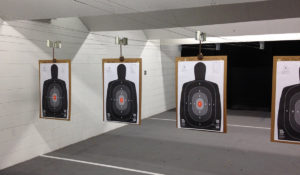 After kicking the tires, performing an inspection, cleaning, and properly lubrication the Springfield XDm Compact 3.8 45, the only reasonable thing would be to take it to the range and get it dirty.
After kicking the tires, performing an inspection, cleaning, and properly lubrication the Springfield XDm Compact 3.8 45, the only reasonable thing would be to take it to the range and get it dirty.
The standard 9-round that comes with the Springfield XDm Compact 3.8 chambered in .45 ACP is specific to the pistol. However, the 13-round magazine (where allowed) is the same magazine used in the XDm 3.8, 5.0, and 5.25 models. The only difference is the addition of the magazine sleeve for the 3.8 Compact. While the 13-round magazine can work without the sleeve, using the magazine sleeve prevents over-insertion of the magazine into the pistol. I would recommend the magazine sleeve even though it adds about $10 dollars to the price of the magazines. A ten dollar magazine sleeve is worth the price to eliminate possible damage to a $500+ pistol. As a side note, a 10-round magazine, if you can find one, is also a concealed carry option that does not negatively impact the pistol’s profile.
Since this was the first time out with the XD(M)® 3.8″ Compact .45ACP, I was more concerned with function than I was for accuracy, but I did try to shoot at a target that was blowing slightly in the indoor range air at a distance of 10-yards as accurately as I could.
I had three brands of ammunition with me to tryout:
- Georgia Arms, Factory-reloaded 230-grain FMJ
- Monarch (PPU ammunition made for Academy Sports) 230-grain FMJ
- Perfecta (Fiochi made for Tula and distributed by Wal-Mart) 230-grain FMJ
The Springfield XDm 3.8 Compact 45 functioned flawlessly with very inexpensive ammunition. The Monarch ammunition was the softest recoiling of the three brands. Surprisingly, the Perfecta ammunition gave the best groups. I have no doubt that with most excellent defensive ammunition, the Springfield XDm 3.8 Compact 45 is going to be an excellent carry piece.
Now, I have shot the Springfield XDs 4.0 45 and the recoil is very controllable, which is surprising for such a small pistol. I expected the XD(M)® 3.8″ Compact .45ACP to shoot similar to the Glock G30. I was wrong in that expectation; the XD(M)® 3.8″ Compact .45ACP was more pleasant for me to shoot than the G30. I also had better accuracy than I did with the first time out with the G30.
As I mentioned in Triggering My Fancy or Fancying My Trigger?, the trigger is very nice, but not perfect. Once the trigger safety is pressed, there is a little take-up to contend with until resistance is felt. I could call this resistance a “spongy wall” – so I will. A little press past the spongy wall results in a very crisp break and the striker releases. It takes some getting used to and the break is very close to the frame. Sometimes, it feels as if you are going to run out of trigger before the trigger finger contacts the frame. Once the striker releases, there is virtually no over-travel of the trigger. The trigger pull is very smooth – even through the spongy wall and does not feel gritty. With some trigger time, the trigger break becomes somewhat predictable and smoother to the pull. With all that said, and if you pull the trigger in one fluid motion, the trigger is exceptional. Two other people shot the Springfield XDm 3.8 Compact 45 and they were impressed with its performance in their hands.
Trigger reset is almost at the point of where the start of resistance is felt. Surprisingly; however, the pistol is quick to get back into action. With that said, I like the trigger on the Ruger SR series better than the Springfield trigger and I like the Springfield trigger better than the Glock trigger. With all that said, I like the trigger on the 1911 better than any of the aforementioned pistols – but this is not about 1911 triggers, although do I use the 1911 trigger as a basis for comparing any pistol’s trigger – striker or hammer fired. As I mentioned earlier, I can adapt to most triggers. Overall, the Springfield XDm 3.8 Compact 45 has a very nice trigger.
Being a relatively light and short pistol, felt recoil is greater than a full-size, all-steel 1911. Felt recoil; however, is not uncomfortable for someone used to the recoil of a .45 ACP cartridge. Some 9mm shooters may find the recoil objectionable, however. That just means that there will be more .45 acp available on the store shelves for those of us who like the cartridge.
Muzzle flip was actually less than I expected. In fact, muzzle flip was far less than I expected. A couple of weeks before this range session, I had the opportunity to shoot the Springfield XDm 5.25 Competition model in .45 ACP. The muzzle flip was actually more with the 5.25 than with the 3.8 Compact. I am going to try and explain why I think that happens.
The way that I understand recoil is that the recoil forces are normally in four directions; up, back, side (twist) and rotational. With a handgun the rotational force is somewhat reliant on the length of the barrel. When the muzzle heads upward due to recoil, there is a tendency for the gun to rotate in the hand. This rotation can be best observed in Western-based single-action revolvers that have a grip that allows the revolver to rotate in the hand, which is actually a good thing because it places the hammer in closer proximity to the thumb for cocking.
With a hand gun with a relatively straight grip angle like the 1911 and most center fire semi-automatic pistols, some of the muzzle rise is mitigated due to the angle of the grip, the hand’s position on the grip, and the center of the bore in relationship to the hand. There is still; however, a tendency for the pistol to rotate in the hand. The rotation point with a long barreled pistol, as with long-barreled revolvers, is more in the firearm itself and usually somewhere around the trigger area. With short-barrel pistol, the rotation point is more rearward and could actually be in the wrist area of the hand. I have noticed that with short-barreled handgun, the entire hand will rise with the firearm and not just the muzzle when the wrists are locked as they are supposed to be. A good beaver-tail also helps to mitigate some of the muzzle rise by forcing the “tail” of the gun into the thumb and shooting finger web in the hand. With a proper grip, and all other factors falling into place, rotation can be minimized as much as possible. I can shoot a 4” .357 magnum revolver with full-loads faster than I can a 1911-based pistol because of these dynamics.
The XDm 3.8 Compact in .45 ACP, like my 1911 EDC, is very easy to get back on target for follow-up shots while I do struggle a bit with the G30. It may well be a combination of barrel length, weight, grip angle, and grip strength for all that I know (and I am far from being an expert), but I just shoot the XDm 3.8 Compact .45ACP well – well enough to seriously consider it for EDC – and that is saying something because I really do like the 1911. With that said I have left the 1911 at times and somehow always returned to it. Maybe, the Springfield XDm 3.8 Compact .45ACP will change that?
The Springfield XDm 3.8 Compact .45ACP functioned flawlessly throughout the range session. I fired mainly 230-grain FMJ ammunition, but I did run a magazine of Remington Ultimate Defense 230-grain BJHP through it afterwards and without issues.
There are a few pistols available that, when held, just feel as if they belong in your hand. The Springfield XDm 3.8 Compact in 45ACp is just one of those pistols for me.
AT HOME ON THE BODY:
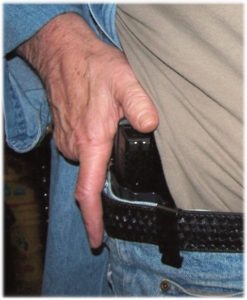 The Springfield XDm Compact 3.8 45 makes for a very concealable package. Of course, I can easily say that carrying a full size 1911-based pistol that, at times, feels like a loose boat anchor in rough seas.
The Springfield XDm Compact 3.8 45 makes for a very concealable package. Of course, I can easily say that carrying a full size 1911-based pistol that, at times, feels like a loose boat anchor in rough seas.
I had a holster from Simply Rugged for the Springfield XD 4” Service Model in .45 ACP that can be worn OWB (belt loops) or IWB (leather straps and snaps) and decided to give it a try with the XDm 3.8 Compact. A little more space for the barrel was not going to hurt anything; the holster was originally intended for a 4” Service XD and the 3.8” length is close enough to 4 inches for government work. The Springfield Armory XDm 3.8 Compact slid right into the holster like it belonged there. However, the SR holster is prone to collapsing as it does not have a reinforced opening. A holster that collapses does not work for me. My search for a good IWB holster was simplified. Once again, I called on SHTF Gear (now known as Black Arch Holsters) for a solution.
An order was placed for an ACE-1 GEN 2 holster (see, REFERENCES) that is expressly fitted for the Springfield XDm 3.8, which will work for both the XDm 3.8 and XDm 3.8 compact (the only difference is in the grip length, which matters not in a holster). Aside from the very reasonable price on these holsters, I happened to catch a free shipping offer. But, I digress.
As a side note, although I ordered the pistol several days prior to ordering the holster, the holster arrived first. Now, that’s customer service!
I have the ACE-1 GEN 2 holster for several pistols including my current 1911 EDC and they are excellent holsters for the money. When the holster arrived, the cant and ride height was adjusted to my liking, and then the holster worn in my favorite position without the Springfield XDm 3.8 nestled snugly in place for a bit to get accustomed to the carry. Once the holster and pistol were mated, the holster and pistol really like each other and I like them both. The XDm 3.8; however, is not quite ready for prime time yet as many more rounds need to be put through it before I am comfortable carrying it as my EDC. The Springfield XDm 3.8 balances well on the hip and in the hand. The weight difference; however, between the Springfield XDm 3.8 and my current Rock Island Armory 1911 FS Standard is substantial. Let’s look at some rough figures while assuming that standard magazines will be used:
I have read people complaining that the Springfield XDm 3.8 45 is heavier than the Glock G30 or the Smith & Wesson. I would like those people to carry a steel, full-fledged 1911 for awhile, then don the Springfield XDm 3.8, and then talk to me about weight.
Even using rough figures, the Springfield XDm Compact 3.8 chambered in .45 ACP is 3/4-pound lighter than what I am currently carrying – the RIA 1911 FS Standard. Perhaps, I will be able to stop listing to the right as I walk.
The Springfield XDm Compact 3.8 chambered in .45 ACP, when housed in a Black Arch Holster, is a very comfortable carry. If you have read any of my reviews on 1911-based pistols mated to SHTF Gear (now Black Arch Holsters), you know that I usually perform surgery on the sweat shield as I do not like using them with a 1911-based pistol. With the Springfield XDm 3.8 Compact 45; however, the sweat shield will be spared surgery as it is excellent for the pistol and I could not ask for better.
I will say that the bulk of the staggered magazines, when carried IWB, takes a little getting used to after carrying two single stack 1911 magazines, but knowing that there is 26-rounds of 11.45mm ammunition on hand is not a bad feeling at all. Now there are those that will state that carrying 38 rounds of 9mm (assuming 2 spare 19-round magazines) or 32 rounds of 40 S&W (assuming 2 spare 16 round magazines) is better than 26-rounds of .45 ACP ammunition. Because of a lower round count, I have often felt that the .45 ACP makes a shooter work smarter and not harder (that should give rise to some comments).
As I had mentioned in a previous topic, I started practicing a different method of removing the pistol from the holster from that I use with a 1911-based pistol. With the 1911-based pistol, and because of the thumb safety, my shooting hand thumb is high and near the thumb safety when drawing the pistol form the holster so that it can quickly disengage the thumb safety when the pistol comes on target. The Springfield XDm 3.8 Compact 45 does not have a thumb safety. The holster for the Springfield XDm Compact 45 has a sweat shield; the sweat shield for my 1911-based pistol has been removed (for safety reasons). The sweat shield on the holster for the Springfield XDm 3.8 Compact 45 is at a near perfect position and angle for guiding my thumb to the grip of the gun, which allows me to get as full a hand grip as possible around the grip of the pistol. I have since found that I can place my thumb on top of the rear sight while my fingers wrap around the grip of the gun and this seems to also allow a full and positive grip since the thumb is pressing down, the fingers are squeezing in and up, and there is some kind of clamping effect going on. This technique is more closely related to the technique that I use with the 1911-based pistol so it is not a hard transition to make. Note that the thumb of the shooting hand is at the same position whether when drawing the pistol from the holster or inserting the pistol into the holster. To me, consistency and safety is important. When the pistol is drawn, the hand tightens. When the pistol is placed in the holster, the hand loosen. Pretty simple, actually.
IN OTHER’S WORDS:
This is the “Don’t just take my word for it!” section that you can use to link to videos and/or non-video reviews. Hickock45 pretty much puts the Springfield XDm Compact 3.8 chambered in .45 ACP through its paces, but also produced a video comparing the Springfield XDm Compact 3.8 chambered in .45 ACP with the Glock G30, which is an excellent comparison between these two pistols and worthy of watching.
- XDm 45 Compact: https://www.youtube.com/watch?v=tR9LOuL8aYI
- XDm 45 Compact VS Glock 30: https://www.youtube.com/watch?v=61mgZT5gNBI
- Glock 30 or XDm Springfield Compact .45? weaponseducation: https://www.youtube.com/watch?v=GXHRlQ3vcQk
- Springfield XDM 3.8 Compact in .45: https://www.youtube.com/watch?v=WfDd_2i6EGY
- Gun review – Springfield XDM 3.8 Compact .45 ACP: http://www.personaldefenseworld.com/2013/02/springfield-xdm-3-8-compact-45-acp/#_dsc6341_phatchfinal
- XDM 45c shooting review: https://www.youtube.com/watch?v=MSUcJeCKzW4
Springfield XDm Compact .45, 13 Plus 1… Glock Killer? weaponseduction: https://www.youtube.com/watch?v=XZ3JhJ1rB7o
CONCLUSION:
The Springfield XDm Compact 3.8 chambered in .45 ACP could be Springfield’s response to Glock’s G30 pistol. Since I have a G30 Gen3, I can say that it is a fair comparison. For me, I prefer the Springfield XDm Compact 3.8 chambered in .45 ACP over the G30 for a number of reasons; the first being safety while carrying and the second being the cost/benefit ratio of the Springfield XDm Compact 3.8 chambered in .45 ACP. For the features that I get for the money that I paid for the gun, the cost/benefit ration far outweighs that of the G30 GEN4. Some may say, “But, you can use a G21 magazine in the G30!” That is not an argument, as the extended magazine for the Springfield XDm Compact 3.8 chambered in .45 ACP provides the same number of available cartridges (13) as the G21 magazine.
I really like the Springfield XDm 3.8 Compact 45. It is an excellent example of how form and function can come together in a single unit.
In closing, I am just going to parrot Springfield Armory:
“If you’re looking for a versatile carry pistol that is packed with features, has amazing capacity, and performs flawlessly, look no farther than the XD(M)® 3.8” Compact. The XD(M)® 3.8” Compact is the smallest of the XD(M)® line, but it’s by no means the least. It boasts the same superior ergonomics, reliable performance, and features that make larger XD(M)®’s easy and intuitive to use in a slightly abbreviated package. And you’ll be amazed at how fun it is to shoot.
If you want a gun for daily carry as well as a trip to the range, but you only want to buy one gun, try the XD(M)® 3.8” Compact. You’ll be amazed at how controllable it is to shoot and how easy it is to conceal. It’s two guns in one.”
REFERENCES:
XD(M)® 3.8″ Compact .45ACP: http://www.springfield-armory.com/products/xdm-compact-45-acp/
Black Arch Holsters: https://www.blackarchholsters.com/products/ace-1-gen-2-holster
SLIDESHOW:
Enjoy a slide show of various Springfield XDm 3.8 Compact 45 features:
![]()



